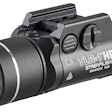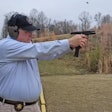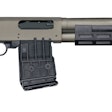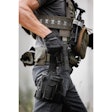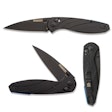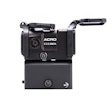If your department is like most American law enforcement agencies, it's caught between the devil and the deep blue sea. On one side, regardless of size and location, it now has to cope with threats to public safety that range from international terrorists to local drunk drivers. On the other, it must make do on a budget that's tighter than a gnat's urethra.
The result is that many departments are looking for ways to minimize the costs of training and even essential gear, including weapons. Unfortunately, this means that you may have to buy your own patrol rifles.
It's likely that the patrol rifle authorized by your agency is going to be an AR-15 in 5.56mm NATO (.223 Remington). The .223 AR-15 offers everything that you need in a patrol long gun.It's accurate, it loads fast, and it shoots fast. More importantly, .223 caliber ammo has the power to punch right through body armor, unless the bad guy is wearing ceramic plates. But .223 rounds won't overpenetrate as much as .308 rounds, and that makes them safer for police use.
The problem with AR-15 rifles is that there are an awful lot of them. A lot of companies make these guns and, combined, they make dozens of different models that range in price from $500 to more than $3,000. So how do you choose which AR to buy with your hard-earned dollars? The only way to cut through this confusion is to shoulder a weapon. And that's exactly what I decided to do with the ArmaLite AR-180B.
A Proud History
ArmaLite introduced its latest version of the AR-180 about two years ago, but the design and the AR-180 designation date to the 1960s. There were very good reasons to update it.
Unlike the original rifle the new version can use M-16 or AR-15 magazines and boasts a weight-saving polymer receiver. But perhaps its most appealing feature, especially to departments and individual officers on a tight budget, is that the law enforcement price of this .223 carbine is just $660.
"Building a new AR-180 was just a natural progression for us," says Mark Westrom, president of ArmaLite. "We've been making parts for owners of the original guns for years. But what we really wanted was to have a rugged semi-auto rifle that could compete price-wise with the Ruger Mini-14 but provide law enforcement agencies and qualified civilians with a tactically more efficient weapon."
It makes sense for ArmaLite to revisit its AR-180. The company does after all have a direct link to the creation of the original AR-15.
In 1961 Fairchild, the parent company of ArmaLite, was undergoing financial problems. The original principals at ArmaLite got together and bought the company from Fairchild. Unfortunately for the buyers, however, Fairchild's designs for the AR-10 and AR-15 rifles had already been licensed to Colt.
Envious of the huge military contracts that Colt was winning with their design, the ArmaLite design team set about to create a rifle that was cheaper to produce, but every bit as battle worthy as the M-16. Their hopes were to cut themselves a slice of the enormous defense department's pie.
ArmaLite's engineers needed to create a weapon with a gas system that didn't violate Fairchild designer Eugene Stoner's patents, which were now owned by Colt. They managed to do so and, in the eyes of many experts, they also managed to create a better rifle than the M-16.[PAGEBREAK]
Rather than use gas to blow back the bolt carrier, like the M-16 does, the AR-180 uses an operating rod that drives the bolt back without introducing gas into the receiver. Less gas in the receiver means a cleaner weapon.
Unfortunately for ArmaLite, the M-16 was just too firmly entrenched with the U.S. military to be displaced by the new upstart, even though it was cheaper to produce and possessed the same level of accuracy. The AR-180 was marketed to civilian consumers.
ArmaLite ran into difficult financial straits in the 1980s and was sold. It changed hands a couple of times after that, but ArmaLite never manufactured another rifle until Westrom resurrected the company in 1995.
The New AR-180
Shooters will immediately notice just how light the new AR-180B is. It weighs just 6 pounds.
Most of the weight savings comes from the innovative new polymer lower receiver. "We decided to go to a polymer receiver for strength," says Westrom. "The old sheet metal AR-180s were notorious for cracking at the welds but you can take one of these plastic receivers and fling it against the concrete floor without cracking it. Polymer yields and reduces stress more so than steel or aluminum. Additionally, the plastic is corrosion proof, costs less to manufacture, and saves about a pound of weight per rifle."
Of course, you can have a lightweight rifle that feels "heavy" because its design yields poor balance. The AR-180B does not have this problem. It feels "light," and it balances just forward of the magazine well. It's not muzzle or butt heavy.
Quality manufacturing is evident throughout the AR-180B. ArmaLite's polymer lower receiver does not display any obvious casting imperfections and the seam between its halves is barely perceptible. Its grayish color also matches the color of the sheet metal upper well.
To reinforce the pin holes, ArmaLite uses steel plates internally on both sides of the receiver. There's no chance that extended firing will cause the pin holes to egg out of shape.
New and Improved
The new AR-180B has a fixed stock that does not fold like the stock on the original AR-180, though it does match it in profile. With the recent expiration of the 1994 Assault Weapons Ban, the folding stock may once again become available on the AR-180B.
Like the original AR-180, the new AR-180B has no external bolt lock. If you'd like to lock the bolt open there are two ways to do it. The easiest way is to lock an unloaded magazine into place and pull the bolt handle rearward. That will lock the bolt to the rear, and the magazine can then be removed. The other way is to stick a finger up into the magazine well and push the internal bolt lock into position while pulling back on the bolt handle. It's not as awkward as it sounds and becomes second nature after a couple outings with the rifle.[PAGEBREAK]
Perhaps the best new feature on the AR-180B is that it now takes any AR-15 magazine. Original AR-180s used a proprietary magazine that was not interchangeable with any other magazines. Fortunately, the new AR-180B can now operate with an M-16 or AR-15 magazine of any capacity.
Also, the lock work of the lower receiver, i.e. the hammer, sear, disconnector, and trigger, can be interchanged with AR-15 parts. If you'd like to fit your new AR-180B with a match trigger, any of the aftermarket kits for the AR-15 will work.
ArmaLite stamps the upper receiver of the AR-180B from a single piece of sheet metal, just like the original rifles. But the welds are neatly dressed, and the cosmetics of the new rifle are far superior to those of the original guns. Especially those manufactured by Sterling. The upper is stamped with the ArmaLite logo on the left side along with the model designation and caliber.
Shots Fired
The AR-180B has several features that enhance its accuracy. For example, to stabilize most popular .223 bullet weights, ArmaLite uses a 1:9-inch twist on the AR-180B's 20-inch-long barrel.
In addition, a non-detachable compensator is affixed to the muzzle. It has two rows of three ports each at the 10 o'clock and 2 o'clock positions and the exit hole is just .242 inches. The compensator is far from being just a cosmetic feature; it's extremely effective in keeping the muzzle climb down during rapid fire.
My test AR-180B digested every type of ammunition that I fed it without any stoppages over the course of my 400-round evaluation. Even the steel-cased ammo like Wolf and Sellier & Bellot fed, cycled, extracted, and ejected without a problem.
Five-shot groups fired from the bench at 100 yards with iron sights averaged about 3.25 inches. That's not bad considering my eyesight and the six-pound trigger pull replete with creep and overtravel.
Locking a four-power scope in place, I was able to produce a 1.48-inch group with Black Hills 69-grain ammo. That proves to me that the new ArmaLite AR-180B is as accurate as most AR-15s. Note: I did not clean the rifle until after the range testing was completed.
Maintenance and Care
Like any good service weapon the AR-180B is extremely easy to disassemble for cleaning. At the rear of the upper receiver is a semi-circular dismount notch. To break down the rifle, all you have to do is take something like a cleaning rod, and push in on the rear of the recoil spring guide rod assembly until it clears the rear of the receiver.
The rifle will now hinge open, pivoting on the front receiver pin. The guide rod assembly and its springs can now be removed from the receiver. Pull the bolt handle back until it lines up with the disassembly cutout in the receiver and remove it from the bolt carrier.
Now the bolt carrier group can be removed from the rifle. Once the guide rod assembly has been removed from the rifle, the upper hand guard can be lifted up and off, giving access to the operating rod, the cylinder, piston, and rod link.
The parts are easy to remove and clean. And reassembly is just as easy. In fact, I purposely tried to assemble the parts incorrectly and found that it was impossible to do.
If your department is on a tight budget and can't afford a high-priced AR-15, perhaps the ArmaLite AR-180B is worth a look. I found it to be an accurate, lightweight, and serviceable rifle that's suitable for patrol duty.
Mike Detty is an NRA certified rifle, pistol, and shotgun instructor. A certified rangemaster and competition shooter, Detty served as an officer in the U.S. Marine Corps and holds a degree in criminal justice from the University of Arizona.










